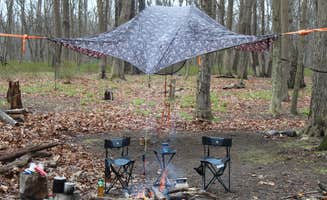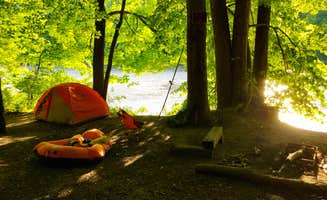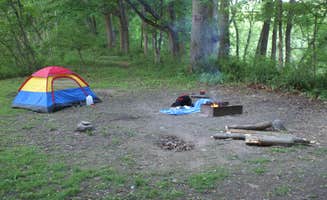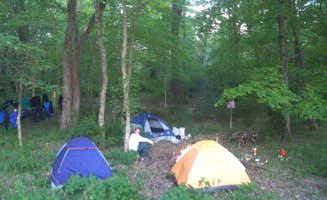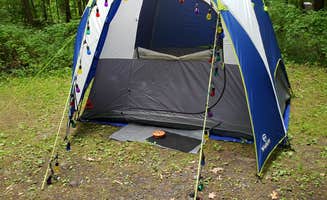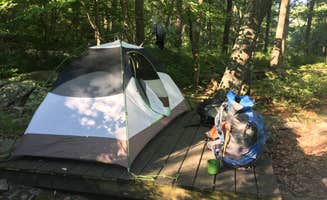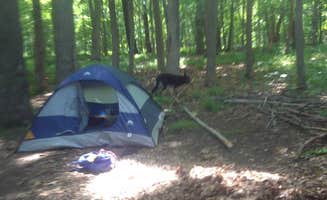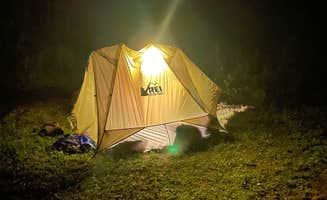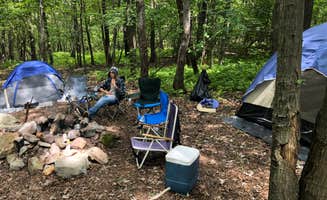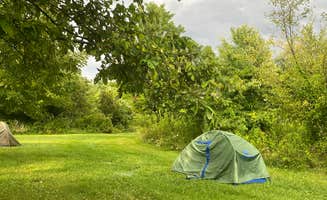Tent camping near Tafton, Pennsylvania centers on the Upper Delaware River valley, which forms part of the 277-square-mile Delaware Water Gap National Recreation Area. The river corridor sits at approximately 400 feet above sea level, with surrounding ridges rising to 1,200 feet. Winter temperatures often drop below 20°F with summer highs regularly exceeding 85°F, requiring seasonal preparation for tent campers visiting primitive sites.
What to do
Waterfall hikes: 3 miles from Sandyston Campsites. Accessible via short trails on the Pennsylvania side, several waterfalls provide day trip opportunities for campers. According to one visitor at Sandyston Boat In Campsites, "Within minutes on the Pennsylvania side of the river you can hike to Raymondskill Falls, (one of many in easy walking distance), as well as search for abandoned/forgotten homes and mills, (some of which date back to the 1700's)."
Packrafting: 4-mile float to campsites. The Delaware River offers numerous put-in points for inflatable boats and kayaks heading to water-access camping. A camper at Namanock Island notes, "I have now taken my packraft to the island twice and have had a fantastic trip each time! The sites are maintained by the NPS and are available on a first come first served basis. Also there is no cost!"
Wildlife viewing: Dawn and dusk best times. Multiple sites provide opportunities to observe local fauna in natural habitats. "As for local wildlife, you can expect to be visited by a masked robber or two during the night, but a bear bag hanging will eliminate any issues," reports a camper from Namanock Island, highlighting the importance of proper food storage.
What campers like
Seclusion: No light pollution for stargazing. Riverside camping offers genuine isolation from urban environments. A visitor at Jenny Jump State Forest shared, "We've been here multiple times. It's so peaceful up there and the scenery is lovely." Many sites feature similar quiet conditions.
Spacious sites: Room for multiple tents. Many campgrounds in the area provide ample space between sites. At Steam Mill Campground, "Each of the camping spots were big and outfitted with picnic benches and fire rings for cooking." Sites often accommodate group camping without feeling crowded.
Island camping: Unique river experience. Water-access camping on islands creates memorable overnight stays. One camper stated, "Its always in nice shape, if not pristine. Group/family accommodating, pet friendly, PRIMITIVE camping that takes you back in time." The isolation of island sites provides a distinctive camping experience not commonly found elsewhere.
What you should know
Access limitations: Boat-only sites require planning. Many prime camping spots cannot be reached by vehicle. "This site is only accessible by canoes or kayaks. There is no public road access to the campsite," explains a reviewer from Sandyston Campsites, emphasizing the need for water transportation.
Primitive facilities: Most sites lack amenities. Prepare for basic camping conditions at most locations. At Alosa Boat In Campsites, "There's usually always a port-a-potty at the campsite. Each area has its own fire ring and multiple river pull offs for easy finding and access." Most sites have minimal facilities.
Seasonal considerations: Peak summer weekends fill quickly. Planning ahead prevents disappointment during busy periods. "During the summer, it is often a challenge to find an open site on a Saturday night, especially if you have gotten a late start on the river or are approaching the southern end of the park," warns a camper about Hornbeck's River Campsites.
Tips for camping with families
Emergency access: Know evacuation routes. Some remote sites maintain emergency access despite their primitive nature. At Alosa Boat In Campsites, "There is an emergency pick up/access road available as well with contact from the park. Reservations are required for this site." This provides peace of mind for families with children.
Campsite selection: Evaluate shoreline access. When camping with children, consider how steep the approach to water sites may be. "The other downside to these sites is the river to camp journey. Due to fluctuating water levels all of the islands that are used for camping have a cut wall cliff style approach," notes a visitor at Hornbeck's River Campsites.
Alternative accommodations: Basic shelters available. For families not ready for tent camping, some areas offer simple structures. A visitor to Jenny Jump State Forest describes, "The 'shelter' is what we would describe as a 'cabin'; four walls, a roof, locking door, locking windows, large picture frame front window, four beds(two bunks), a wood burning stove, and a porch."
Tips from RVers
Size restrictions: Small trailers only. Most campgrounds in the area cannot accommodate large recreational vehicles. At Steam Mill Campground, sites are described as "for people truly there to camp, either in a tent or small travel trailer." Standard-sized RVs will find limited options.
Limited hookups: Prepare for boondocking. Even drive-in sites typically offer minimal services. "It is primitive so there are no other facilities at the sites," notes a camper, reflecting the general lack of electric, water, and sewer connections throughout the region.
Parking access: Reserve well ahead for holiday weekends. Limited parking at river access points creates logistical challenges. "I paid 20 for day and overnight parking at Milford beach. Paddle about 4 miles to the site," explains a solo camper, highlighting both the cost and distance considerations for those bringing boats to reach river sites.




